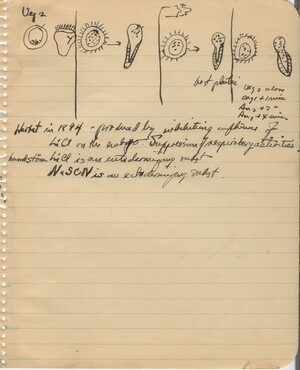Trinkaus, John Phillip - Papers
Notes from Oscar Schotte's lecture. Trinkaus concludes the outline that he started on page 100 with notes on "1. Equatorial eggs" (with diagrams) and "2. Subequatorial eggs". Trinkaus then begins notes on Runstrom's "Double Gradient Theory" (with a diagram)
Notes from Donald Costello's lecture. Trinkaus concludes his series of diagrams on the development of the barnacle embryo (beginning on page 48), with two late stage/adult barnacle diagrams
Notes from William Ballard's lecture. Trinkaus takes notes on degeneration during growth (includes diagram)
Notes from Oscar Schotte's lecture on "Echinoderm Embryology". Trinkaus takes notes on the phylogeny of echinoderms, and begins notes on echinoderm eggs.
Notes from Oscar Schotte's lecture. Trinkaus continues his notes on general information about the eggs of echinoderms, then begins notes on the history of research on echinoderms
Notes from Oscar Schotte's lecture. Trinkaus continues his notes on the echinoderm egg, with diagrams and discussion of Jenkinson (1911) study of sea urchin egg formation. Two diagrams show the egg attached to the wall of the ovary and the structure of the egg.
Notes from Oscar Schotte's lecture. Trinkaus continues his notes from the previous page on recombination experiments for the different cell stages (with diagrams). Trinkaus creates an illustrated chart of Horstadius' different recombination experiments
Notes from Oscar Schotte's lecture. Trinkaus concludes his illustrated chart of Horstadius' recombination experiments and finishes the lecture notes with information on the effects of different chemicals on development
Notes from Oscar Schotte's lecture. Trinkaus begins notes on "Exp. Embryology of the Echinoderms" with an outline on "Reversal of Polarity" from Horstadius (inludes diagrams"
Notes from Oscar Schotte's lecture. Trinkaus takes notes on the experiments and theories of Driesch, C. Herbst (with diagram), and Rubstrom (with diagram)
Notes from Oscar Schotte's lecture. Trinkaus continues his notes on Runstrom's work from the previous page, then begins a section on Lindahl's egg constriction experiments (with diagram). Begins section on "Vegetalization" with information about normal development and the effects of different chemical compounds (with diagrams)
Notes from Oscar Schotte's lecture. Trinkaus continues his notes on vegetalization with information about the effects of different chemical compounds on development (includes diagram). Trinkaus begins new section, "Animalization" with several diagrams and information on different chemical compounds












